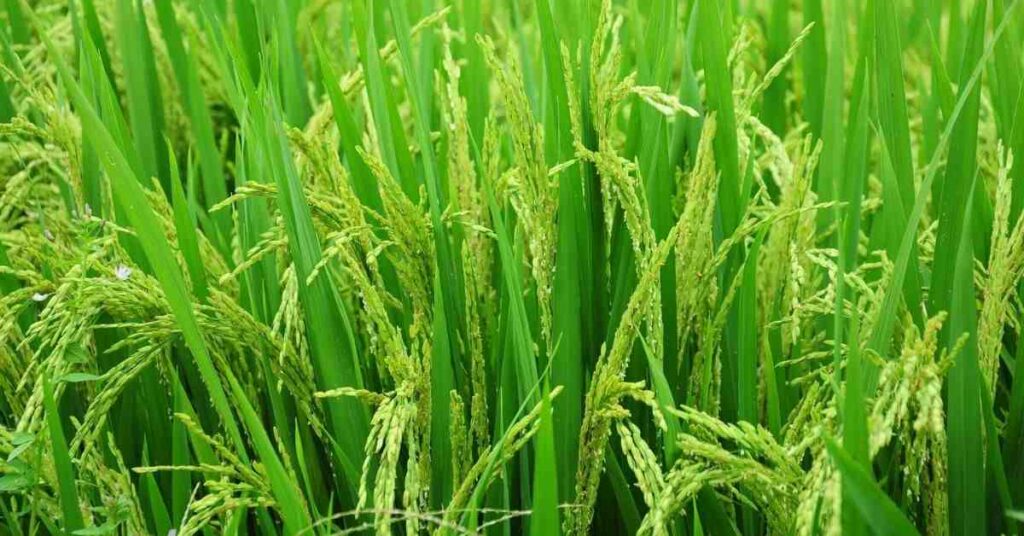Rice is one of the world’s major food crops. Rice is the staple food of more than half of the world’s population, so we must know about rice diseases and their control measures. Here we will know in detail about the diseases of rice, their symptoms, management and prevention measures.
Brown spot of rice
Brown spot of rice is caused by a fungus called Helminthosporium oryzae. It is a seed borne disease. In paddy crop, this disease can occur at any time from the seedling stage to the stage of grain formation.This disease occurs more commonly in potash deficient soil.This disease attacks the leaves and grains of plants, but the symptoms of the disease are more clearly visible on the leaves.
Symptoms
- Small, sesame shaped round or oval brown spots are formed on the leaves.
- A yellow circle is formed around these spots and the center of the spots is yellowish brown in color.
- As the disease progresses, the spots coalesce, enlarge and spread over the entire leaves and eventually the leaves dry up.
- Brown or black spots are also formed on the peels of the grains, due to which the grains appear discolored.
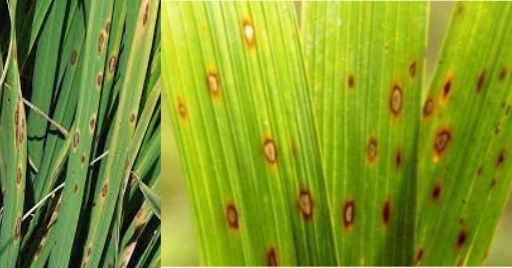
Management/control
- Use a balanced amount of plant nutrients (fertilizers) in the field.
- Sow the seeds after treating them with a fungicide.
- For the control of Brown spot of rice, spray the following fungicides:
- Propiconazole 25% EC : 200-250 ml/acre in 150-200 liters of water
- Hexaconazole 5% SC : 250 ml/acre in 150-200 liters of water
- Azoxystrobin 11% & Tebuconazole 18.3% w/w SC : 300 ml/acre in 150-200 liters of water
Rice blast
Rice blast is caused by a fungus called Magnaporthe grisea. Rice blast disease is also known as rotten neck and rice fever. This disease was first recorded in India in the year 1918. This disease is found in about 80 rice growing countries. In case of severe infestation of this disease, crop loss can be up to 70-80%.
Symptoms
The disease affects the leaves, nodes and neck (base of the panicle) of the plant but the symptoms of the disease are more clearly visible on the leaves.
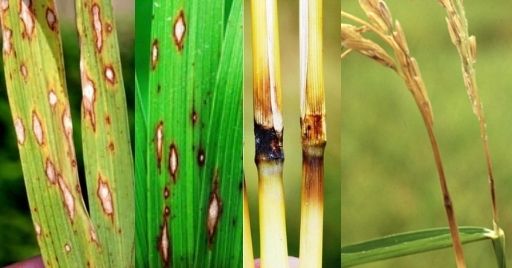
Leaf blast
First small specks are formed on the leaves, later these specks enlarge and appear on the leaves as a spindle or eye shape (0.5 to 1.5cm length, 0.3 to 0.5cm width). The edges of these spots are brown in color and the middle part is gray in color. Later, many spots coalesce and form large irregularly shaped spots on the leaves, due to which the leaves get scorched and dry up.
Neck blast
In neck blast, the base of the panicle shrinks and dark spots are formed all around. If this type of infection occurs before the earrings emerge, then the earrings come out straight and the granules in the earrings are partially formed or not completely formed. But if the infection occurs after the emergence of earrings, then the panicle breaks and hangs due to the death of the tissues, which can cause a huge loss of grains.
Node blast
The nodes of the plants affected by the disease turn black and break.
Management/control
- Sow healthy seeds and transplant disease-free seedlings only.
- Nursery should not be grown in shady areas.
- Use a balanced amount of fertilizers, avoid excess Nitrogen.
- Sow disease-resistant varieties like IR-64, Pusa Basmati-1637.
- Do not use nitrogenous fertilizer when symptoms of the disease appear.
- Seed should be sown after treating with Carbendazim 50% WP @ 2g/kg of seed.
- Spray the following chemicals when symptoms of the disease appear:
- Hexaconazole 5% SC : 250 ml/acre in 150-200 liters of water
- Tebuconazole 50%+ Trifloxystrobin 25% w/w WG : 500 gm/acre in 150-200 liters of water
- Kasugamacyin 3% SL : 400-600 ml/acre in 150-200 ml off water
- Tebuconazole 250 EC : 1-1.5 ml/liter of water
Tungro disease of rice
Tungro disease of rice is caused by viruses called Rice tungro bacilliform virus (RTBV) and Rice tungro spherical virus (RTSV). In paddy, this disease is transmitted by leafhoppers. Where green leafhoppers are responsible for transmitting most diseases. Tungro disease affects the crop at all stages of growth but most commonly at the stage of vegetative growth.
Symptoms
- The growth of the plants affected by the disease is stunted and tillerings are also reduced.
- Older leaves begin to turn orange-yellow at the tips and extend down to the lower leaf portion.
- Flowering is delayed and small and weak panicles are also formed, which are dark brown in color.
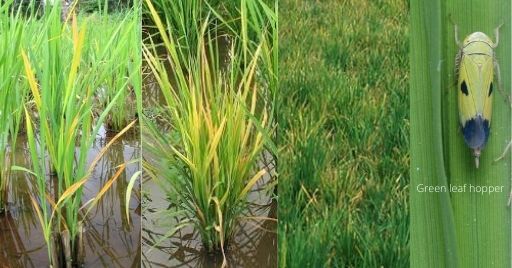
Management/control
- In areas where the disease spreads more, crop rotation of oilseeds or leguminous crops should be adopted.
- After harvesting, do deep plowing to destroy stubbles.
- Light traps can be installed to attract and control leafhoppers.
- Spray Thiamethoxam 25 WDG 100g/acre or Imidacloprid 17.8 SL 50-70ml/acre at 15 and 30 days after transplanting of paddy.
- Spray insecticide on the weeds of the bunds as well.
- To reduce the yellowing of leaves caused by disease, spraying can be done by mixing 2% urea solution with Mancozeb 2.5 g/liter solution.
Khaira disease of rice
Khaira disease of rice is caused by the deficiency of zinc. Khaira disease of rice is a physiological disorder. In this disease, the lower leaves of the plants start turning yellow and after that, brown spots appear on the leaves. In case of severe outbreak of the disease, the leaves start drying. Plant growth is stunted and tillering is reduced. Symptoms of khaira disease are seen more in high yielding varieties of paddy.
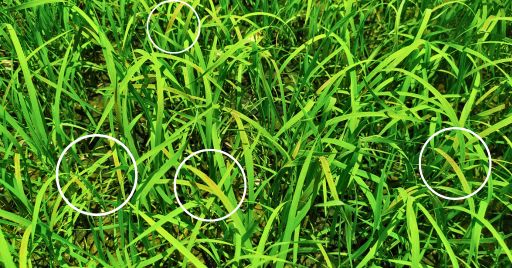
Management/control
- To avoid the problem of this disease, 25 kg zinc sulfate per hectare should be applied before transplanting at the time of preparation of the field.
- For the control of Khaira disease, spraying of 5 kg Zinc Sulfate and 2.5 kg Lime in 600-700 liters of water per hectare should be done when the initial symptoms of the disease appear.
- If the disease is still not under control, then 10 days after the first spray, the second spray should be done at the same rate.
- Transplanting after soaking the ‘roots of plants’ in 2% zinc sulfate solution for 1-2 minutes is also beneficial.
Bacterial leaf blight
Bacterial leaf blight of rice is a bacterial disease, caused by Xonthomonas oryzae pv. oryzae. This disease can occur at any time from the seedling stage to the mature stage of the plants.
Symptoms
- In this disease, long dry lesions begin to form from the tip of the leaf and move towards the central part of the leaf through the edge.
- Wavy spots appear on the edges of the leaves.
- In case of severe infestation of the disease, the entire leaf dries up.
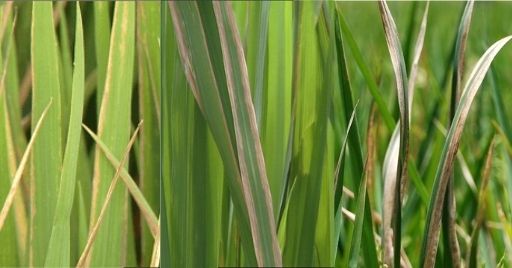
management/control
- Water should be drained from the field when symptoms of the disease appear.
- Use a balanced amount of fertilizers.
- If the crop shows signs of disease, apply less amount of nitrogen fertilizers.
- Sow only healthy and treated seeds.
- For the control of bacterial leaf blight, spray the following bactericides and fungicides:
- Copper Oxychloride 50 % WP: 500 gm/acre in 150-200 liters of water
- Streptomycin sulphate 90% + Tetracycline hydrochloride 10% SP: 6 gm in 50 liters of water spray on the foliage and infected plants
- Kasugamycin 5% + Copper Oxychloride 45% WP: 300 gm/acre in 150-200 liters of water
Sheath blight of rice
Sheath blight of rice is caused by a fungus called Rhizoctonia solani. The symptoms of this disease start appearing from the paddy nursery. After planting in the field, the symptoms of the disease appear at the last stage of tillering.
Symptoms
- In this disease, irregularly shaped spots are formed on the leaf sheath just above the ground or water surface.
- These spots are 2-3 cm long, green to brown in color, which later become straw colored (pale yellow color).
- Purple stripes are formed around the spots.
- In severe outbreak of disease, the mycelium is clearly visible on the lesions, on which semi or fully spherical brown sclerotia are formed.
- Circular spots are formed on the leaves.
- Under favorable conditions, many small spots coalesce to form large spots, due to which the sheath, stem, leaves become completely affected; Eventually the plants die.
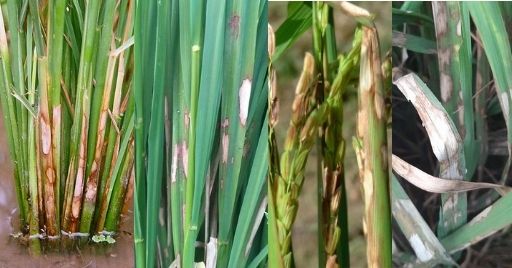
Management/control
- Keep fields and bunds weed free.
- Use a balanced dose of fertilizers and apply the total amount of nitrogen in 2-3 times.
- Sow only healthy and treated seeds.
- Sow the seeds after treating with Carbendazim 50% wp @ 2 g/kg of seed.
- For the control of Sheath blight of rice, spray the following fungicides:
- Tebuconazole 250 EC: 1-1.5 ml/liter of water in 150-200 liters of water
- Azoxystrobin 11% & Tebuconazole 18.3% w/w SC: 300 ml/acre in 150-200 liters of water
- Carbendazim 50% WP: 100-200 gm/acre in 150-200 liters of water
- Kresoxim-methyl 40% + Hexaconazole 8% WG: 1 gm/liter in 200 liters of water
Rice Bakanae / Foot rot Disease
Rice Bakanae / Foot rot / Foolish Seedling Disease is caused by a fungus called Gibberella fujikuroi, it disrupts the normal growth pattern of rice seedlings, leading to significant yield losses. Gibberella fujikuroi infects rice plants through contaminated seeds or soil. The fungus produces a plant hormone (gibberellin) that disrupts normal growth regulation.
Symptoms
- Excessive Elongation: Infected seedlings grow abnormally tall and thin, appearing “foolish” compared to healthy plants.
- Yellowing and Thinning: Leaves become pale yellow and lack vigor.
- Root Lesions: Brownish lesions may develop on the roots, hindering nutrient uptake.
- Reduced Tillering: Infected plants produce fewer tillers, resulting in fewer potential grain heads.
- Poor Grain Development: In severe cases, infected plants may not produce any grains, or the grains may be underdeveloped and sterile
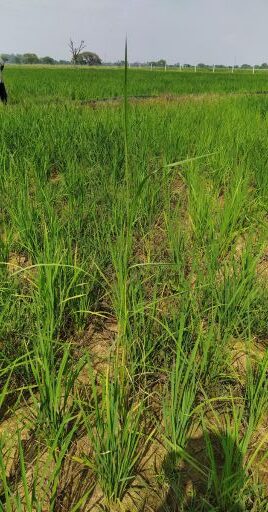
Management / control
- Clean Seed: Use certified disease-free seeds to prevent initial infection. Seed treatment with thiram 2gm/kg seed or thiophanate-methyl 2-3gm/kg seed can be an additional measure.
- Crop Rotation: Planting non-rice crops for a season helps reduce the fungus population in the soil.
- Sanitation: Removing and destroying infected plant debris after harvest eliminates potential overwintering sites for the fungus.
- Balanced Fertilization: Avoiding excessive nitrogen application can help reduce disease severity.
- Resistant Varieties: This disease is more susceptible in PB-1509, So sow only disease resistant varieties.
- For the control of Rice Bakanae / Foot rot Disease, spray the following fungicides:
- Mancozeb 63% + Carbendazim 12% WP: 300 gm/acre in 150-200 liters of water
- Tebuconazole 50%+ Trifloxystrobin 25% w/w WG: 500 gm/acre in 150-200 liters of water
- kresoxim-methyl 40% + Hexaconazole 8% WG: 1 gm/liter of water in 150-200 liters of water per acre
- Hexaconazole 4% + Carbendazim 16% SC: 400 ml/acre in 150-200 liters of water
False Smut of Rice
False smut of rice, also known as Lakshmi disease, is a fungal disease that affects paddy crops. It is caused by the fungus called Ustilaginoidea virens. While typically not causing catastrophic yield loss, it can significantly reduce grain quality and economic return for farmers. Early and accurate diagnosis followed by effective management strategies are crucial for minimizing the disease’s impact.
Symptoms
The most noticeable symptom of false smut is the presence of velvety, greenish-black spore balls on the rice panicles. These spore balls:
- Develop from individual rice grains.
- Initially orange and gradually turn greenish-black as they mature.
- Usually only affects a few grains per panicle, leaving the rest unaffected.
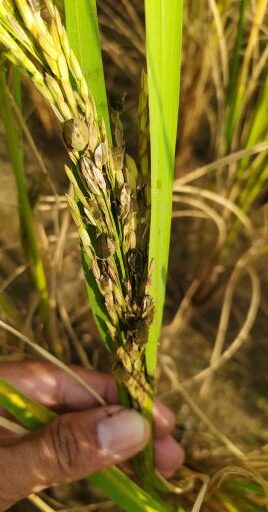
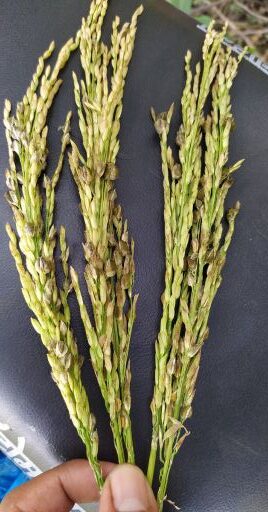
Management / control
There are several methods to control false smut in rice:
- Crop rotation: This disrupts the life cycle of the fungus by preventing it from establishing itself in the soil.
- Field sanitation: Remove and destroy infected plant debris after harvest to reduce the amount of inoculum (spores) available for the next crop.
- Water management: Avoid practices that create constantly wet conditions, as this favors the growth of the fungus.
- Planting-resistant varieties: Some rice varieties are more resistant to false smut than others.
- Seed treatment: Fungicide seed treatment can help to prevent infection.
- For the control of False smut of rice, spray the following fungicides:
- Azoxystrobin 11% & Tebuconazole 18.3% w/w SC: 300 ml/acre in 150-200 liters of water
- Azoxystrobin 18.2% + Difenoconazole 11.4% SC: 200 ml/acre in 150-200 liters of water
- Validamycin 3% L : 500 ml/acre in 150-200 liters of water
Sheath Rot of Rice
Sheath rot of rice is a complex disease caused by a combination of fungal and, in some cases, bacterial pathogens. It can significantly reduce rice yield and grain quality, posing a threat to food security in many rice-growing regions.
- Fungi: The primary fungal culprit is Sarocladium oryzae, though other Fusarium species might also be involved.
- Bacteria: In some instances, the bacterial pathogen Pseudomonas fuscovaginae can act in conjunction with the fungus, further worsening the disease.
Symptoms
- Leaf Sheath Rot: The initial signs appear on the uppermost leaf sheath encasing the young developing panicles.
- Discoloration: Brownish or grayish-brown spots with gray centers form on the sheath.
- Stunted Panicle Emergence: The infected sheath restricts the emergence of the panicle, sometimes causing it to remain partially or entirely trapped within.
- Rotting and Powdery Growth: In severe cases, the trapped panicles rot, and a whitish powdery fungal growth appears inside the sheath.
- Grain Discoloration: When the bacteria Pseudomonas fuscovaginae is involved, grain discoloration might also occur.
- Reduced Yield: Sheath rot significantly reduces rice yield by:
- Hindering or preventing panicle emergence.
- Leading to unfilled or sterile panicles.
- Causing grain discoloration and reduced quality.
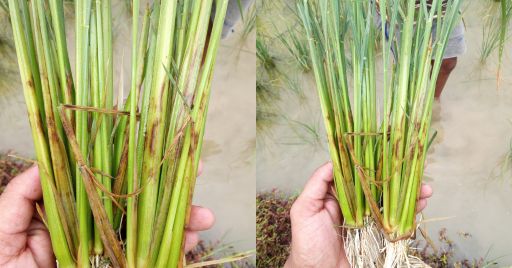
Management / control
- Healthy Seeds: Using disease-free, certified seeds minimizes the risk of introducing the pathogen.
- Insect Control: Minimize insect infestation, as wounds created by insects can serve as entry points for the fungus.
- Crop Residue Management: Properly manage crop residue after harvest, as the fungus can survive on leftover plant material.
- Balanced Fertilization: Apply fertilizers, particularly nitrogen, in balanced proportions to avoid weakening the rice plant’s defenses.
- Planting Density: Maintain optimal plant spacing to improve air circulation and reduce humidity within the rice canopy.
- Potassium Application: Applying potash at the tillering stage can strengthen the rice plant’s cell walls, making them more resistant to infection.
- Calcium and Zinc Sprays: Foliar sprays of calcium sulfate and zinc sulfate might offer some benefit.
- For the control of False smut of rice, spray the following fungicides:
- Carbendazim 50% WP: 100-200 gm/acre in 150-200 liters of water
- Kasugamycin 5% + Copper Oxychloride 45% WP: 300 gm/acre in 150-200 liters of water
- Metalaxyl 8% + Mancozeb 64% WP: 300-500 gm/acre in 150-200 liters of water
Note: Any recommendations regarding the use of chemicals are for informational purposes only. Before using any type of chemical for weeds, diseases, and pest control, consult the nearest agriculture shop or a local agricultural consultant.
How helpful was this post for you, tell me in the comment box and you can also give us your advice, your comments and advice are very important for us.
Thank you..!
